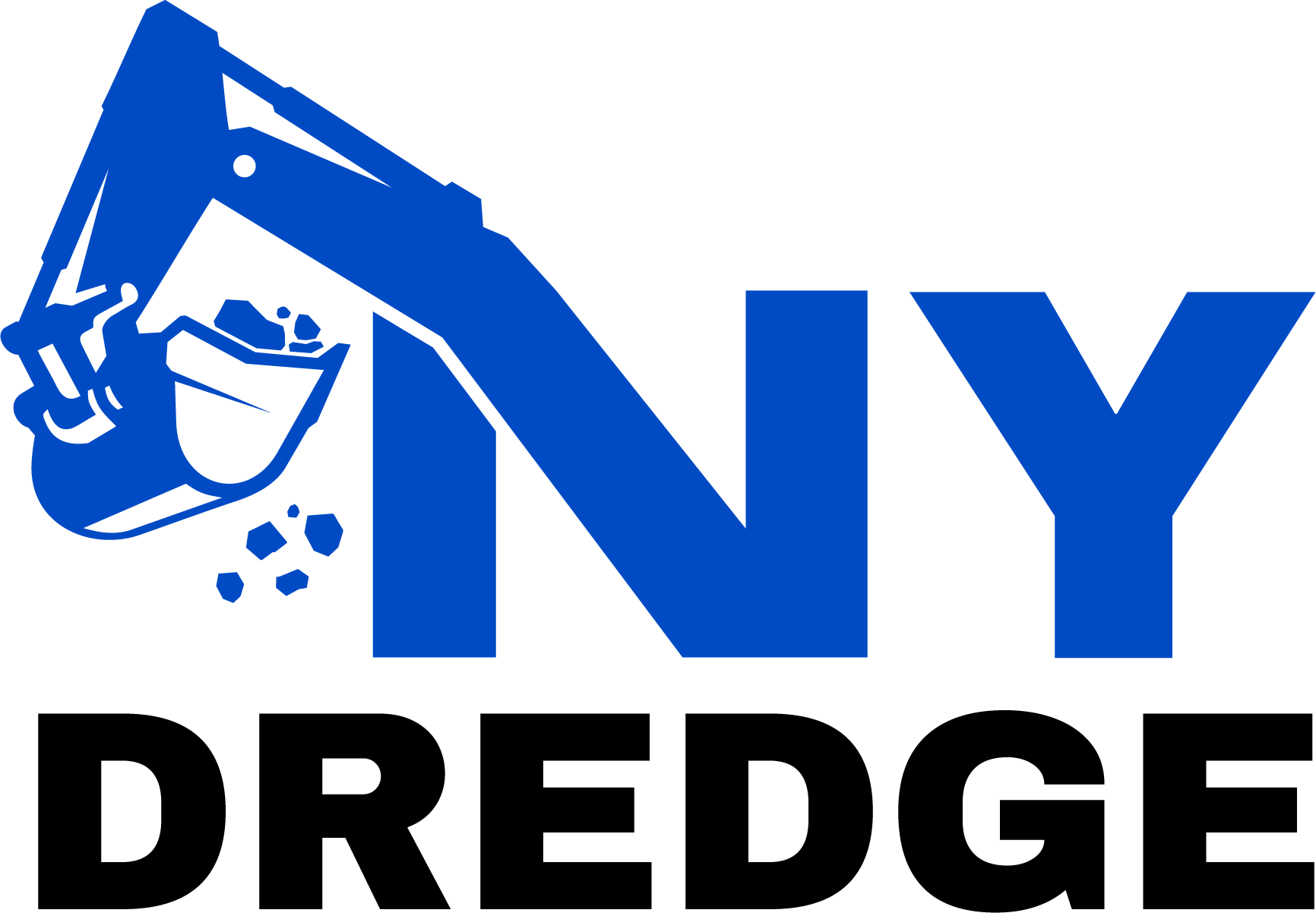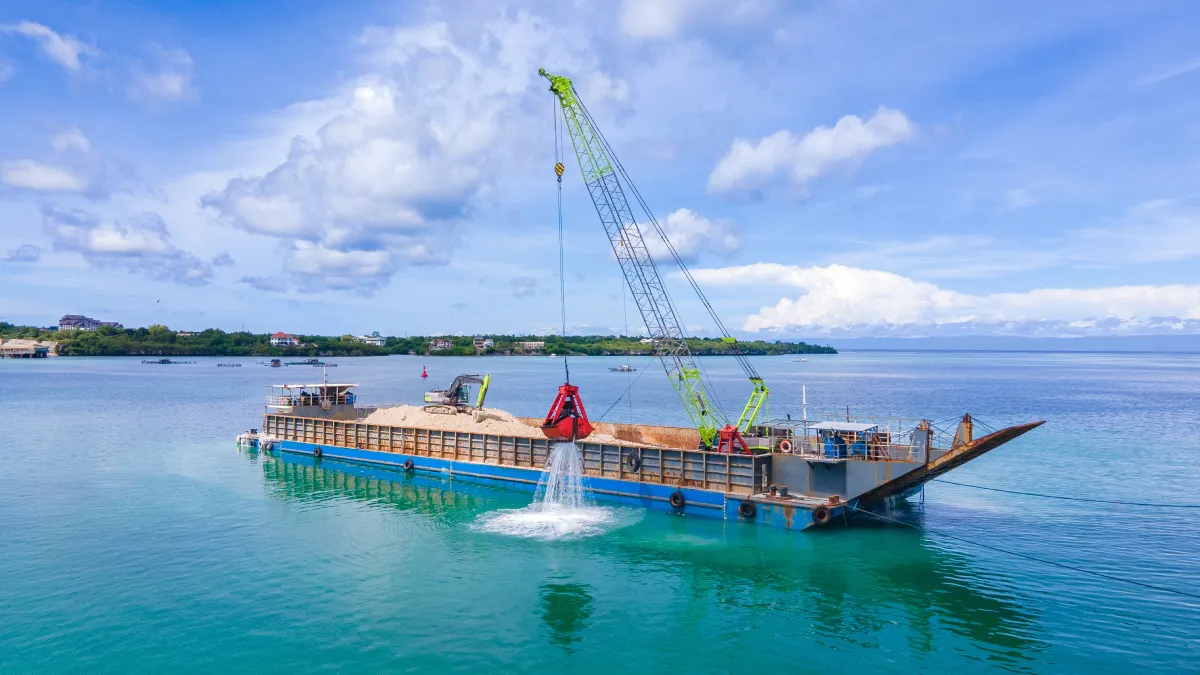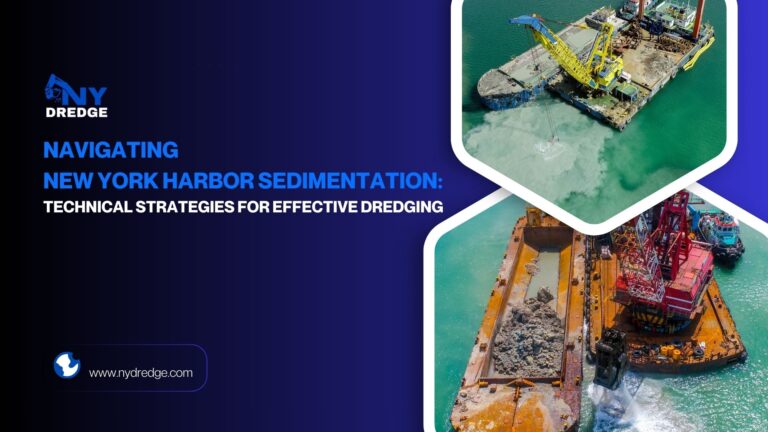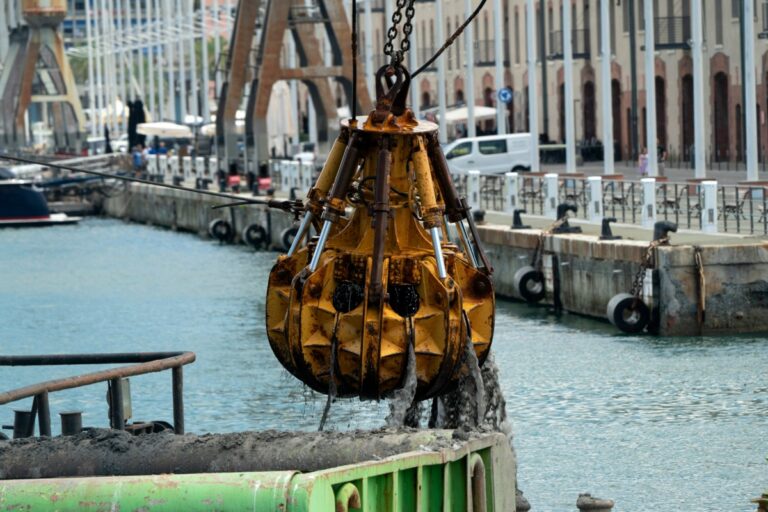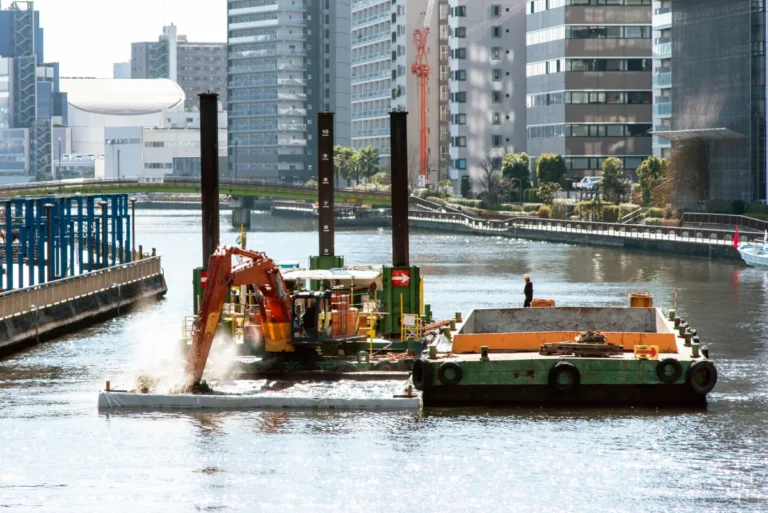In any dredging project, selecting the right dredge barge is fundamental to achieving efficient, safe, and cost-effective operations. From inland pond restoration to large-scale coastal reclamation, the barge acts as the structural and operational foundation that supports pumps, pipelines, and power systems. Understanding how factors such as size, payload, power integration, and regulatory compliance interact helps project planners choose a configuration that maximizes production and minimizes downtime. A well-matched dredging barge not only enhances performance but also extends the operational life of equipment and ensures compliance with modern environmental standards.
Understanding the Role of a Dredge Barge in Modern Dredging
A dredge barge serves as the central working platform in most dredging operations, providing the necessary stability, buoyancy, and mobility to support pumps, excavation systems, and material transport. Whether it’s removing accumulated silt from industrial lagoons, reclaiming sand for construction, or maintaining navigable waterways, the dredging barge acts as the structural foundation that anchors the entire dredging process. Its design directly affects the project’s reach, efficiency, and overall output capacity.
In technical terms, a dredge barge is a floating structure engineered to house or support dredging equipment such as cutterheads, suction pumps, discharge pipelines, and control systems. Depending on the scope of work, it may also include spud systems for anchoring, hydraulic power units (HPUs), and auxiliary storage for fuel or slurry handling. The layout and load-bearing capacity are carefully calculated to ensure balance and operational safety under varying hydraulic loads.
Modern dredging operations make use of several dredging barge configurations, each designed to serve specific project conditions and production goals:
- Standalone Dredge Barges with Integrated Pumps
These are self-contained systems where the dredge pump, engine, and control systems are all mounted directly on the barge. Ideal for compact projects such as sand pit dredging, canal maintenance, or lagoon cleaning, standalone barges simplify mobilization and reduce setup time while delivering continuous suction and discharge performance.
- Modular Floating Platforms with Interchangeable Equipment
Increasingly popular for their flexibility, modular dredge barges consist of interlocking float sections that can be assembled and transported using standard shipping containers. This configuration allows operators to switch between different pump sizes, power systems, or cutter attachments based on sediment type or project scale. Modular barges are especially suited for sand dredging barge applications where quick deployment and scalability are essential.
- Support Barges for Transport, Slurry Pipelines, and Power Units
In larger dredging operations, support barges work in conjunction with the main dredge unit to handle critical auxiliary tasks—such as carrying discharge pipelines, housing hydraulic power units, or transporting excavated material to designated disposal areas. These barges improve overall efficiency by distributing the functional load across multiple platforms, allowing continuous dredging with minimal downtime.
The evolution of the dredge barge has transformed dredging from a labor-intensive process into a precision-driven, scalable operation adaptable to marine, mining, and industrial applications.
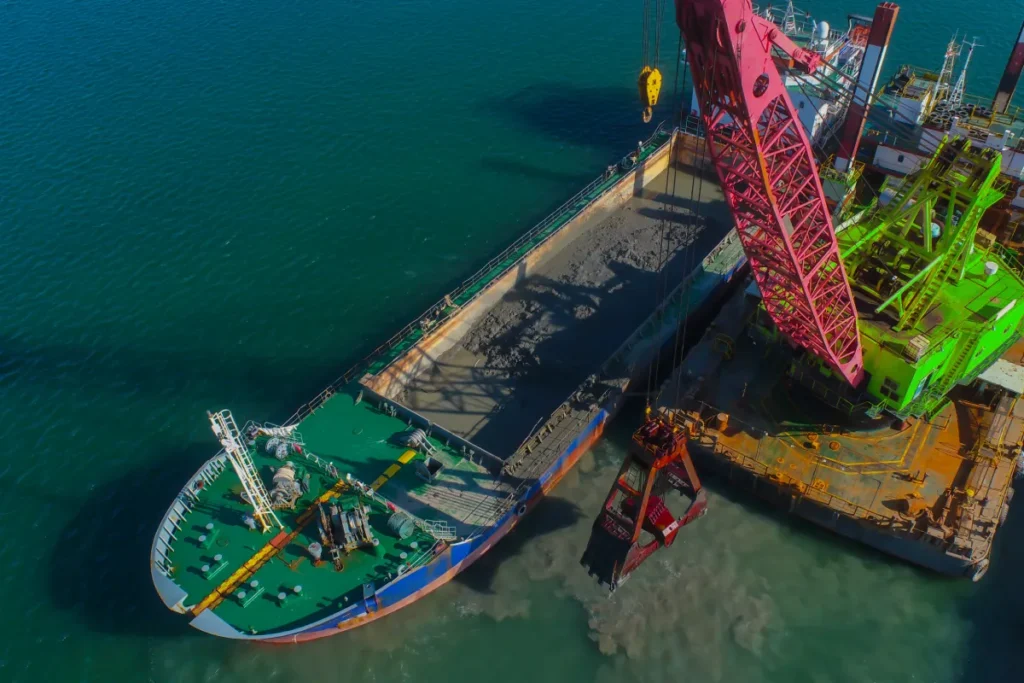
Size and Configuration: Matching Barge Dimensions to Project Scope
Selecting the correct dredge barge size and configuration is one of the most critical early-stage decisions in any dredging operation. The physical dimensions, displacement, and draft depth of the barge determine where it can operate, what equipment it can support, and how much material it can handle per cycle. A mismatch between barge capacity and project conditions can lead to reduced efficiency, safety issues, or costly downtime.
The draft depth—the distance between the waterline and the bottom of the barge hull—plays a decisive role in determining where the dredging barge can be deployed. Shallow draft barges are ideal for inland or nearshore work, while deeper draft vessels are built for open-water and heavy-load dredging where larger equipment and slurry volumes are involved.
Below are the most common operational environments and how barge dimensions influence performance in each:
- Shallow Water Lagoon Dredging
Compact modular barges with a shallow draft (typically under 3 ft) are preferred for lagoons, ponds, or wastewater facilities. These barges can maneuver in confined areas without damaging the bottom or disrupting nearby infrastructure.
- Riverbed or Sand Mining
Medium-sized barges with moderate draft and deck strength are used for sand and gravel extraction. The barge should be able to carry heavy-duty slurry pumps and pipelines while maintaining balance under variable loads during material discharge.
- Port and Harbor Maintenance Dredging
Large dredging barges or multi-section floating platforms are suited for coastal and harbor projects, where deeper drafts and higher load capacities are necessary to support high-powered pumps, booster stations, and extended discharge pipelines.
To illustrate how barge size and configuration align with project type and material volume, the table below provides a simplified comparison:
| Barge Size (L × W × H) | Typical Use Case | Capacity Range (CY / m³) |
| 20 × 8 × 4 ft (6 × 2.4 × 1.2 m) | Lagoon dredging, pond maintenance | 50–100 CY (38–76 m³) |
| 30 × 10 × 5 ft (9 × 3 × 1.5 m) | Riverbed sand dredging, small mining ops | 150–250 CY (115–190 m³) |
| 40 × 8 × 4 ft (12 × 2.4 × 1.2 m) | Mid-size sand mining, construction fill | 250–400 CY (190–305 m³) |
| 60 × 12 × 6 ft (18 × 3.6 × 1.8 m) | Harbor dredging, marine infrastructure | 500–800 CY (380–610 m³) |
| 80 × 20 × 8 ft (24 × 6 × 2.4 m) | Offshore dredging, reclamation projects | 1000+ CY (760+ m³) |
Choosing the right barge dimensions isn’t just about payload—it’s about ensuring the right balance between buoyancy, pump compatibility, and site accessibility. Properly sized sand dredging barges enhance operational stability, reduce fuel consumption, and enable sustained high-production dredging in any environment.
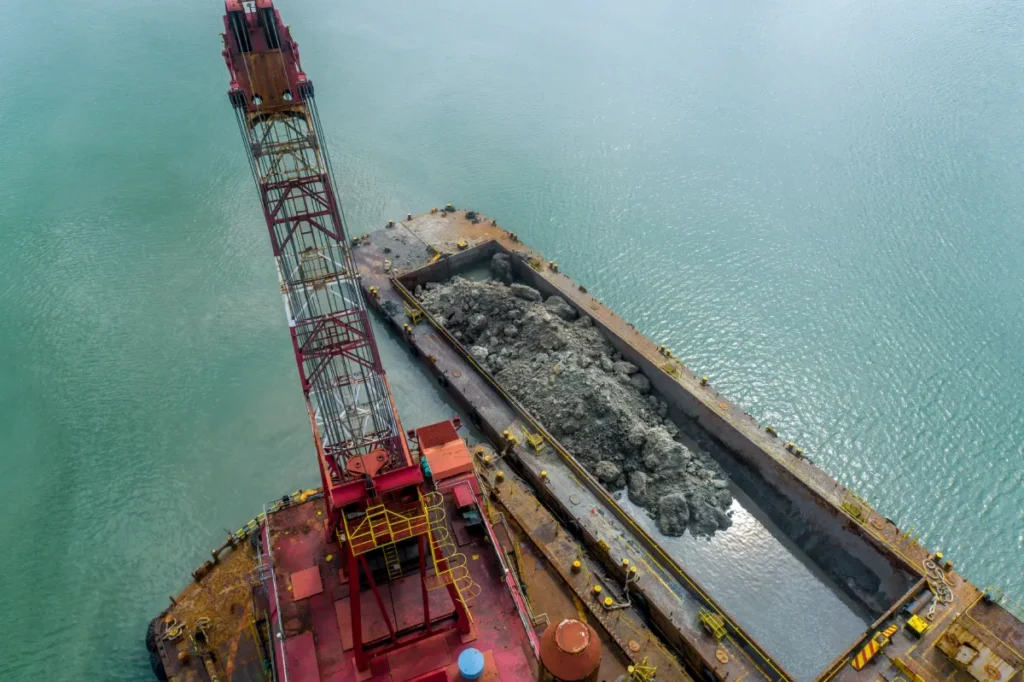
Capacity and Payload: Evaluating Material Volume and Equipment Weight
Determining the capacity and payload of a dredge barge is essential to ensure safe, efficient, and continuous operations. The barge must be able to handle not only the dredged material but also the combined weight of pumps, pipelines, fuel, crew, and auxiliary systems without exceeding its buoyancy or stability limits. A properly calculated payload ensures optimal dredge performance, prevents structural stress, and maintains balance under changing load conditions.
The hopper or deck load capacity of a dredge barge can be estimated by calculating the maximum displacement minus the vessel’s lightship weight (the weight of the empty barge). The remaining value represents the usable carrying capacity for dredged material, equipment, and fuel. For material transport barges, this figure directly determines how much slurry or dry sediment can be loaded in each cycle. In contrast, for pump barges, it sets the upper limit for equipment weight and onboard systems.
Several key factors influence capacity planning and payload distribution:
- Material Density (Sand, Silt, Gravel)
The type of material being dredged has a direct impact on barge loading. Sand and gravel have much higher densities (1.6–2.0 t/m³) compared to silt or organic sludge (0.9–1.2 t/m³). This means a sand dredging barge may reach its maximum load volume faster than one handling fine silt, even if both hold the same volume of material.
- Discharge Distance and Pump Power
The total head and discharge length determine the pump’s required horsepower and, consequently, the size and weight of the hydraulic power unit (HPU). Longer pumping distances or high-elevation discharge points demand larger pumps and more fuel storage—both of which increase overall deck load. Balancing equipment placement is critical to avoid listing or uneven draft.
- Fuel and Auxiliary Equipment Weight
Components like hydraulic hoses, winch systems, spud poles, and control cabins contribute significant static weight. Fuel and lubricants also add to the operational payload, especially for self-propelled or diesel-powered dredging barges. Estimating their combined mass helps maintain proper ballast and ensures stable operation across all loading conditions.
A well-calibrated payload strategy allows operators to maintain a steady production rate, minimize downtime between offloads, and optimize dredging cycles. When evaluating barge capacity, engineers typically account for a safety margin of 10–15% to compensate for variable sediment density and operational fluctuations. This margin ensures that the dredge barge maintains adequate freeboard, stability, and pumping performance even under heavy-duty workloads.
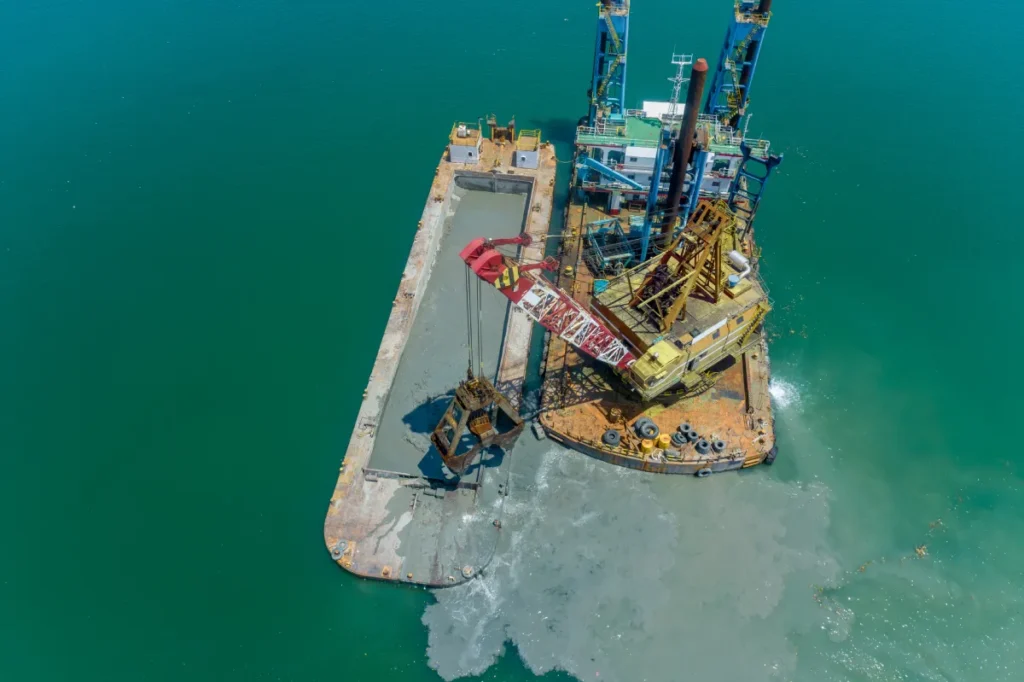
Power and Pump Integration
The efficiency of a dredge barge relies heavily on how well its power system and pump configuration are integrated into the platform’s design. Each element—pump, hydraulic power unit (HPU), and barge structure—must operate in harmony to achieve consistent slurry production, stable operation, and safe load distribution. Compatibility between these components determines the system’s performance under variable dredging conditions such as sediment density, discharge head, and flow rate.
A key consideration in power and pump integration is aligning the pump’s output (measured in GPM and head pressure) with the barge’s buoyancy, deck strength, and center of gravity. Overloading one side with an oversized pump or fuel-heavy HPU can affect stability, particularly in shallow or confined water bodies. Proper load balancing, equipment anchoring, and hydraulic line routing are essential to maintain both production efficiency and vessel safety.
Modern dredging barge systems can be configured in several power setups, depending on operational scale, fuel availability, and environmental requirements:
- Electric-Powered Dredge Barge Setups
These systems use electric motors powered by shore connections or onboard generators. Electric drives provide consistent torque, low noise, and reduced emissions—ideal for industrial pond cleaning, wastewater lagoon dredging, and environmentally sensitive projects. They also simplify the integration of automation and real-time control.
- Diesel-Driven HPUs with Remote Control
This is the most common configuration for high-production sand dredging and mining operations. Diesel engines drive hydraulic pumps that power the main dredge pump, cutterhead, or agitators. Remote control units allow operators to monitor RPM, pressure, and flow rate from the deck or a control room, minimizing manual intervention and enhancing safety in long-duration dredging cycles.
- Hybrid Systems with ROV or Automated Dredge Heads
These combine diesel or electric HPUs with remotely operated dredge heads (ROVs) or submersible pump systems. Such setups are used for deepwater or hazardous environments where precision and safety are critical. Hybrid integration enables variable-speed control, energy optimization, and higher solids-handling efficiency while maintaining barge stability through evenly distributed power modules.
In every configuration, the alignment between pump performance and barge buoyancy is vital. The barge must be able to support dynamic loads during suction and discharge without excessive roll or pitch. Engineering teams typically calculate trim and list tolerances to ensure that the dredge barge remains balanced under full operational load, preserving both structural integrity and production efficiency throughout the dredging cycle.
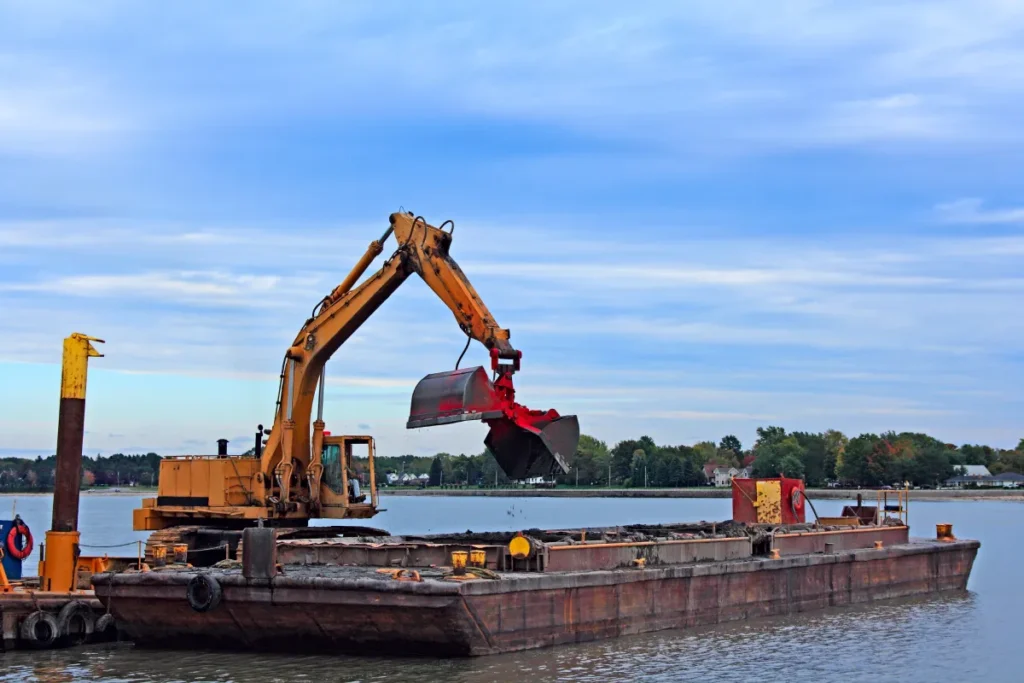
Equipment and Accessories That Define Efficiency
The performance of a dredge barge is determined not only by its pump and power system but also by the range of supporting equipment and accessories that enhance control, stability, and production efficiency. These components enable smoother dredging cycles, reduce downtime, and ensure consistent material flow—especially when working in challenging environments such as viscous sludge, uneven bottoms, or long discharge routes. Properly selected accessories can transform an average dredging system into a high-performance, precision-driven operation.
Some of the most effective equipment and accessories that define operational efficiency include:
- Jetting Rings or Agitators for Viscous Sludge
Jetting rings and mechanical agitators are critical when handling thick or thixotropic materials. They help liquefy the sediment, improving suction consistency and preventing pump clogging. In sand dredging barge setups, these accessories enable higher solids concentrations and steady production rates even in compacted or layered deposits.
- Discharge Pipeline Floats and Quick Couplers
Floating pipeline systems reduce drag and wear on hoses during discharge operations, especially over long distances. Quick couplers simplify pipeline assembly and breakdown, minimizing downtime between dredging cycles and facilitating rapid site relocation. The combination of floats and couplers enhances the barge’s reach while maintaining flexibility and buoyancy in variable water conditions.
- Spud Systems and Winch Packages for Stability
Spud poles provide vertical anchoring that prevents lateral drift during dredging, maintaining the barge’s position and excavation accuracy. Winch systems complement spuds by allowing controlled barge movement along a dredging path without manual repositioning. Together, they provide stability and precise line control—essential for both dredging barge and modular platform operations in currents or confined spaces.
- Optional GPS or RTK Control for Precision Dredging
Advanced GPS or Real-Time Kinematic (RTK) systems allow operators to monitor dredge head position, depth, and coverage in real time. This technology minimizes over-dredging, ensures compliance with design depths, and improves overall production mapping. It is particularly valuable in large-scale reclamation or environmental restoration projects where accuracy and reporting are crucial.
When integrated correctly, these components work as an interconnected system—enhancing performance, reducing fuel consumption, and improving consistency. Each piece of support equipment directly influences how effectively a dredge barge converts power into measurable productivity, ensuring that every gallon of fuel or kilowatt of energy translates into efficient material movement.
Operational Environments: Choosing the Right Barge Type for the Job
The effectiveness of a dredge barge largely depends on matching its design and capacity to the operating environment. Each dredging setting—whether inland, coastal, or offshore—presents unique challenges related to water depth, sediment type, current strength, and accessibility. Selecting the right barge configuration ensures consistent production, minimal downtime, and longer equipment lifespan.
- Inland Dredging (Ponds, Lagoons, Sand Pits)
For confined or shallow environments, compact and modular dredging barges are the most effective. These barges feature shallow drafts, lightweight construction, and the ability to be transported easily by truck or container. A sand dredging barge in this category typically supports submersible or cutterhead pumps, enabling efficient sediment removal in ponds, reservoirs, and industrial lagoons without draining the water body.
- Coastal Dredging (Estuaries, Harbors, Beach Nourishment)
Coastal operations demand mid-sized dredge barges with moderate draft and enhanced stability to handle waves, tides, and higher slurry volumes. These setups often use diesel-driven hydraulic systems and spud anchoring mechanisms for controlled movement. In beach nourishment or harbor maintenance, a medium-capacity dredging barge paired with booster pumps provides an optimal balance between portability and production.
- Offshore Dredging (Reclamation, Deep-Sea Operations)
Offshore environments require heavy-duty barges engineered for rough seas, long pumping distances, and large material volumes. These barges feature deep drafts, reinforced hulls, and high-horsepower pumps capable of moving thousands of cubic yards per hour. A large-scale sand dredging barge equipped with automated positioning and deep-sea anchoring systems performs best here, supporting reclamation and infrastructure projects that demand both endurance and precision.
Regulatory and Logistical Considerations
Every dredge barge project must align with strict regulatory and logistical frameworks that govern maritime operations, environmental protection, and equipment transport. Compliance is not just a legal requirement—it’s a critical factor that influences project approval timelines, operational costs, and long-term sustainability.
Maritime and Environmental Standards (EPA, MARPOL, etc.)
Dredging activities often operate under national and international environmental regulations. Agencies like the Environmental Protection Agency (EPA) in the U.S. and conventions such as MARPOL (International Convention for the Prevention of Pollution from Ships) establish limits on water discharge quality, fuel emissions, and sediment disposal practices. A compliant dredging barge must incorporate systems for spill prevention, containment, and waste management to reduce ecological impact. Additionally, operators are required to maintain records of dredging volumes, sediment characteristics, and discharge zones for environmental audits and project certification.
Transport and Deployment Regulations
Logistics play a crucial role in barge mobilization, especially when transporting equipment across regions or countries. Large, single-piece barges often require special transport permits, escort vehicles, and route approvals, which can increase project setup time and costs. Oversized loads must comply with Department of Transportation (DOT) or equivalent maritime transport regulations governing load limits, axle weights, and route restrictions.
Advantages of Modular Dredging Barge Designs
To overcome logistical challenges, modern manufacturers increasingly favor modular dredge barge designs. These barges are built in sectional units—typically 20x8x4 ft or 40x8x4 ft modules—that can be shipped using standard flatbed trucks, rail containers, or ocean freight without requiring oversized permits. Once on site, they can be quickly assembled using interlocking connections and pinned joints, reducing mobilization time and labor costs by as much as 40%.
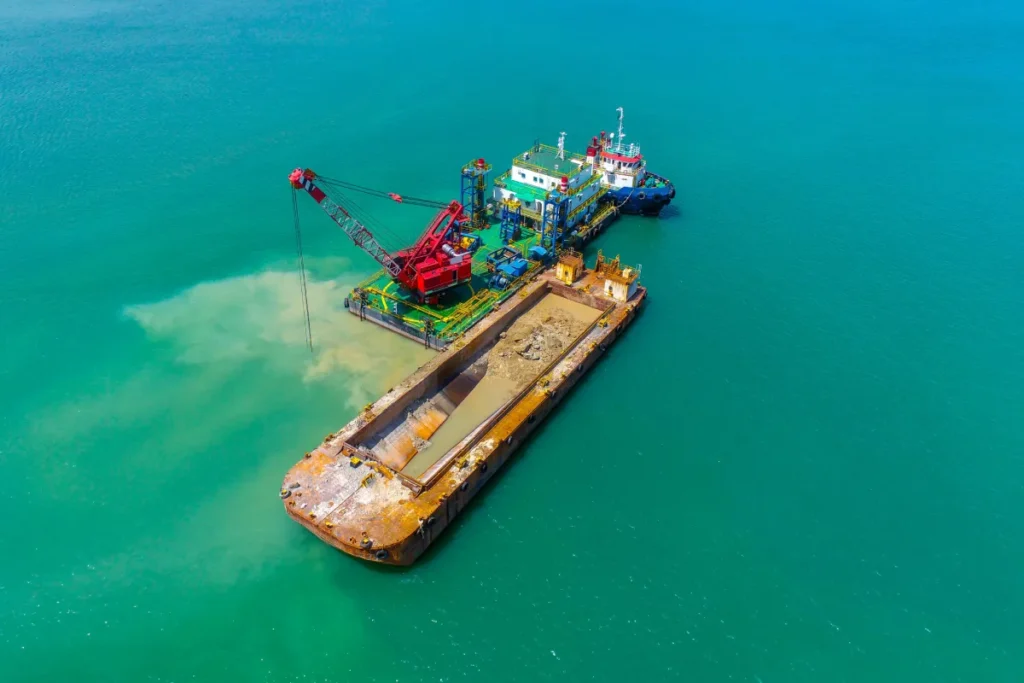
Maintenance, Safety, and Longevity Factors
A well-maintained dredge barge delivers reliable performance, lower operating costs, and a significantly longer service life. Given the harsh environments in which these vessels operate—saltwater exposure, abrasive sediment, and heavy-duty mechanical loads—routine maintenance and proactive safety measures are essential to preserving both structural integrity and crew safety.
Effective maintenance programs focus on preventive inspections, timely repairs, and corrosion protection to ensure uninterrupted operation. Some of the most important practices include:
- Anti-Corrosion Coatings and Steel Grade Selection
Applying marine-grade epoxy or zinc-rich coatings protects the hull and deck surfaces from saltwater oxidation and chemical corrosion. Using high-strength, corrosion-resistant steel (such as ASTM A36 or equivalent) for hull fabrication further enhances durability in abrasive dredging environments.
- Regular Inspection of Pontoons, Spuds, and Deck Fittings
Periodic checks for cracks, weld fatigue, and water ingress in pontoons prevent structural failures. Spud poles and deck fittings should be inspected for wear and alignment to maintain anchoring stability and even load distribution during dredging operations.
- Engine and HPU Maintenance Cycles
Routine servicing of diesel engines, hydraulic pumps, filters, and cooling systems ensures consistent power delivery and prevents unplanned downtime. Monitoring oil levels, pressure gauges, and hydraulic line integrity helps extend component lifespan and improve system efficiency.
Alongside mechanical upkeep, safety considerations play an equally critical role. Dredge barges should undergo stability checks to verify load balance and buoyancy under varying operating conditions. Crew access systems—such as non-slip walkways, guardrails, and safety ladders—must be maintained to ensure secure movement on deck. In addition, installing emergency flotation measures and clearly marked evacuation points helps safeguard personnel during unforeseen incidents.
A disciplined maintenance and safety protocol not only extends the operational lifespan of a dredging barge but also reinforces overall project reliability, ensuring steady production and compliance with maritime safety standards.
Making the Right Decision: Key Takeaways for Project Planners
Selecting the optimal dredge barge requires a balanced assessment of technical, operational, and logistical factors. Each element—from barge size to pump configuration—directly affects production efficiency, safety, and long-term project economics. Before finalizing your dredging setup, project planners should evaluate the following key parameters:
- Size and Load Requirements
Determine the ideal barge dimensions based on dredging volume, water depth, and available maneuvering space. Ensure the platform can safely support all onboard systems and maintain stability under full payload conditions.
- Pump Compatibility
Match the barge’s deck strength and buoyancy with the selected dredge pump and power system (electric, diesel, or hybrid). The integration should deliver the required flow rate and discharge head without overloading the vessel’s structural limits.
- Dredging Environment and Sediment Type
Align barge configuration with the operational setting—whether inland, coastal, or offshore. Sediment characteristics such as density, viscosity, and debris content influence pump selection, draft depth, and required accessories like jetting rings or spud systems.
- Logistical and Regulatory Aspects
Factor in transport regulations, site accessibility, and compliance with maritime and environmental standards (EPA, MARPOL, etc.). For faster mobilization and reduced costs, consider modular barge systems that simplify shipping and assembly.
By systematically reviewing these factors, planners can ensure that their dredging barge investment aligns with both immediate production needs and long-term operational efficiency. The right choice not only improves ROI but also enables smoother, safer, and more sustainable dredging operations across diverse marine and industrial applications.
Conclusion: Building Efficiency from the Barge Up
Choosing the right dredge barge goes beyond capacity or horsepower—it’s about aligning design, performance, and compliance to create a system that delivers consistent results in any dredging environment. By focusing on proper sizing, equipment integration, and operational safety, contractors can secure higher efficiency and lower lifetime costs. At New York Dredge, we help clients identify, customize, and deploy dredging solutions built for long-term reliability and performance. Talk to us today to find out how we can support your next dredging project with the right equipment and technical expertise.
